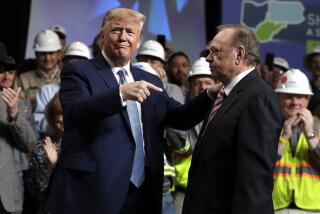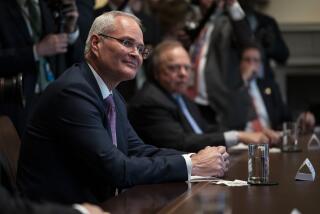The Company Presidency
WASHINGTON — Enron’s spectacular collapse has put scores of politicians on the defensive because of their pro-Enron voting records and their war chests full of Enron dollars. Even some Cabinet officials are squirming over their past relationships with the energy company. It’s all an unsettling echo of Teapot Dome, the government-oil-reserve-loan scandal of the Harding presidency, which became a symbol of the financial and political abuses of the 1920s.
In 1921, the U.S. Interior Department rigged the leasing of California’s Elk Hills and Wyoming’s Teapot Dome naval oil reserves after Interior Secretary Albert B. Fall received “loans” from oilmen Edward L. Doheny and Harry Sinclair. The loans of cash and stock were in the $400,000 range, with a “gift” of $100,000 from Doheny.
Both Teapot and Enron involved energy policy, privatization and corruption. And like Teapot Dome’s “Ohio gang” of ethically loose Harding cronies, oilmen and administration officials--energy deregulation during the first Bush administration, through the Clinton years and George W.’s time as governor of Texas on up till today has been warped and feasted upon by a Texas-led “Enron gang.” In both scandals, some Democrats were involved, but the power centers of misbehavior were Republican.
Yet, there has been nothing quite like the rise and fall of Enron in U.S. history, certainly no plausible comparison since the late-19th-century heyday of railroads and robber barons. The sums in Enron’s collapse certainly overshadow those in Teapot, much as a space shuttle does a Model T Ford. More important, not in memory has a single major company grown so big in tandem with a presidential dynasty and a corrupted political system. Indeed, the Bush family has been a prominent and well-rewarded rung in Enron’s climb to national political influence.
In retrospect, it’s unclear whether the Bush dynasty built Enron or vice versa. In 1985, when Enron was formed, the Bushes were an important political family. George Bush, as vice president, headed the Reagan administration’s task force on energy policy. But in terms of Texas oil money and stature, the Bushes were third echelon. When George W. ran for governor of Texas in 1994, Ann Richards, the Democratic incumbent, joked that of the oil companies he had started or been involved with, none had made a profit. Enron’s rise, with the Bush family’s help, in the 1990s rearranged the energy power structure in Texas and the nation, and put the Bush entourage in clover. The question now is whether what went up together will come down together.
As early as 1988, when his father was president-elect, George W. Bush lobbied the Argentine government on behalf of an Enron pipeline proposal. Bush, through his staff, has denied making a telephone call on Enron’s behalf, but Rodolfo Terragno, the Argentine minister of public works and services at the time, insists he did. When newly elected President Carlos Menem made a sweetheart deal with Enron, freeing the corporation of certain Argentine tariffs and taxes when doing business in the country, lawmakers demanded an investigation, and a special prosecutor undertook the task. But since his Justice Department was already “investigating,” Menem fired the prosecutor.
From 1988 to 1992, Bush the elder collected hefty political contributions from Enron. When president, it was his ambassador in Buenos Aires who had pushed for favorable tax treatment for Enron in Argentina. Bush asked Enron chief Kenneth L. Lay to co-chair a host committee for the July 1990 G-7 economic summit in Houston and appointed him to his Export Council in late 1990. A year earlier, Bush energy officials began work on the 1992 Energy Policy Act. Its provisions obliged utility companies to carry and transmit Enron-generated electricity, which contributed to the company’s subsequent huge growth. In 1992, Lay was named co-chairman of the Bush reelection campaign and chairman of the host committee of the Republican National Convention in Houston.
In December 1992, Bush’s Commodity Futures Trading Commission, chaired by Wendy L. Gramm, wife of Texas GOP Sen. Phil Gramm, created a legal exemption that allowed Enron to begin trading energy derivatives--another growth enhancer for the company. When Bush left the White House in 1993, Enron made Wendy Gramm a company director and signed a joint consulting and investing agreement with James A. Baker III, Bush’s secretary of State, and Robert A. Mosbacher, his Commerce secretary. The two were to do Enron’s global deal-making for natural-gas projects.
How much the Bush family and its close political entourage actually collected from Enron and its executives since the company was organized is a matter of definition--reportable political contributions, soft money for the Republican Party, finders’ fees, joint investments, inauguration funding, presidential-library donations, speech money, capital gains, consulting fees, directors’ fees or what? If you combine what the multiple Bush generations received with what loyalists Vice President Dick Cheney, Baker, Mosbacher, political advisor Karl Rove, economic advisor Lawrence B. Lindsey and U.S. Trade Representative Robert Zoellick got, you certainly have $6 million to $8 million, and depending on the success of the Baker-Mosbacher-Enron joint investments, perhaps $20 million to $30 million.
On top of which, 29 top Enron executives and board members (and its accounting firm, Andersen), the majority of whom were significant Bush contributors in 2000, are being sued by Enron shareholders to recover $1.1 billion made by the 29 in alleged insider trading of Enron stock.
But let us return to Texas in 1995. George W. Bush has been elected and inaugurated as governor. Enron chairman Lay and Joe B. Allen of Vinson & Elkins, Enron’s Houston law firm, are his top fund-raisers. Lay also chairs the governor’s Business Council, and press reports have Lay writing regularly to Bush, seeking favors, recommending appointments and asking the governor to receive visiting dignitaries from places where Enron hoped to do business.
Bush began pushing Enron-backed deregulation in his first year as governor. In 1997, he urged then-Pennsylvania GOP Gov. Tom Ridge to support an Enron-backed energy-deregulation plan for the state. Then in 1999, Bush succeeded in getting a kindred deregulatory blueprint enacted in Texas.
By 2000, Bush was running for president and, once again, Enron’s checkbook was open. Lay and Enron would be Bush’s biggest corporate contributor, with Vinson & Elkins not too far behind. This was the year when Lay also sent a memo to company employees urging them to contribute personally to Bush through the Enron Political Action Committee.
Enron’s roster of advisors and lobbyists became a pay-station for senior Bush campaign strategists and advisors: Lindsey, former Christian Coalition honcho Ralph Reed and Zoellick.
When the 2000 presidential election ended up in the Florida courts, Enron helped fund the Bush campaign’s expenses, a fitting gesture because the effort’s captain was Baker, the old Enron deal-maker, with Enron advisor Zoellick--known also as Baker’s “second brain”--back as first lieutenant. Then when the U.S. Supreme Court decided the election, Lay and his fellow power brokers popped the figurative champagne cork with a $300,000 contribution to the Bush-Cheney inaugural gala.
In Washington, the Enron gang--let’s call them the “E team”--also included Sen. Gramm and Texas Reps. Dick Armey, the House majority leader, and Tom DeLay, House majority whip. All received large Enron contributions--Gramm collected $100,000 over 12 years, the second-largest draw in Congress--and their voting records were supportive of Enron causes. Gramm’s decision last September to retire from the Senate may have stemmed from his worry that he might be politically vulnerable for being a leading supporter of 2000 legislation that facilitated Enron’s entry into commodity derivatives markets and exempted the company from key financial reporting requirements, while his wife was an Enron director with sizable company holdings.
Enron boosters who landed government jobs are Patrick H. Wood III, the former Texas Public Utilities Commission chairman who now heads the Federal Energy Regulatory Commission (FERC), and Nora M. Brownell, a former pro-Enron public-utilities commissioner in deregulated Pennsylvania, who is also a FERC member. White House personnel chief Clay Johnson, a former energy lawyer in Houston; Army Secretary Thomas E. White, a former Enron senior executive; Commerce Department general counsel Ted Kassinger, a former Enron advisor and trade lawyer with Vinson & Elkins; Montana ex-Gov. Marc Racicot, the former Enron lobbyist recently named Republican National Committee chairman by Bush.
The drafting of a Bush federal energy policy fell into the vice president’s lap. A previous Enron shareholder and a friend of Lay’s, Cheney had run the Halliburton Co. One of its divisions built Houston’s Enron Field, the new home of the Houston Astros baseball team. Cheney’s chief of staff, Lewis Libby, was an Enron stockholder. Cheney, who refuses to say what he and Lay discussed in their private meetings, and the General Accounting Office, an investigating arm of Congress, is suing the vice president to obtain that information.
Enron’s largess has even compromised law enforcement. U.S. Atty. Gen. John Ashcroft has recused himself from Enron-related matters because of large Enron political contributions he received while a Missouri senator. Deputy Atty. Gen. Lawrence Thompson, from the Enron-representing Atlanta law firm of King & Spalding, is also under pressure to follow his lead. The office of the U.S. attorney for the Southern District of Texas, which includes Houston, has had to recuse itself en masse.
In the months and years ahead, as the congressional and criminal investigations fill in the details of the Enron story, the collapse of Enron may, like Teapot Dome, come to symbolize an era of financial and political excess. If so, there is even some chance that it could do for the memory of Bush what those California and Wyoming oil leases did for the memory of Harding.
More to Read
Inside the business of entertainment
The Wide Shot brings you news, analysis and insights on everything from streaming wars to production — and what it all means for the future.
You may occasionally receive promotional content from the Los Angeles Times.










